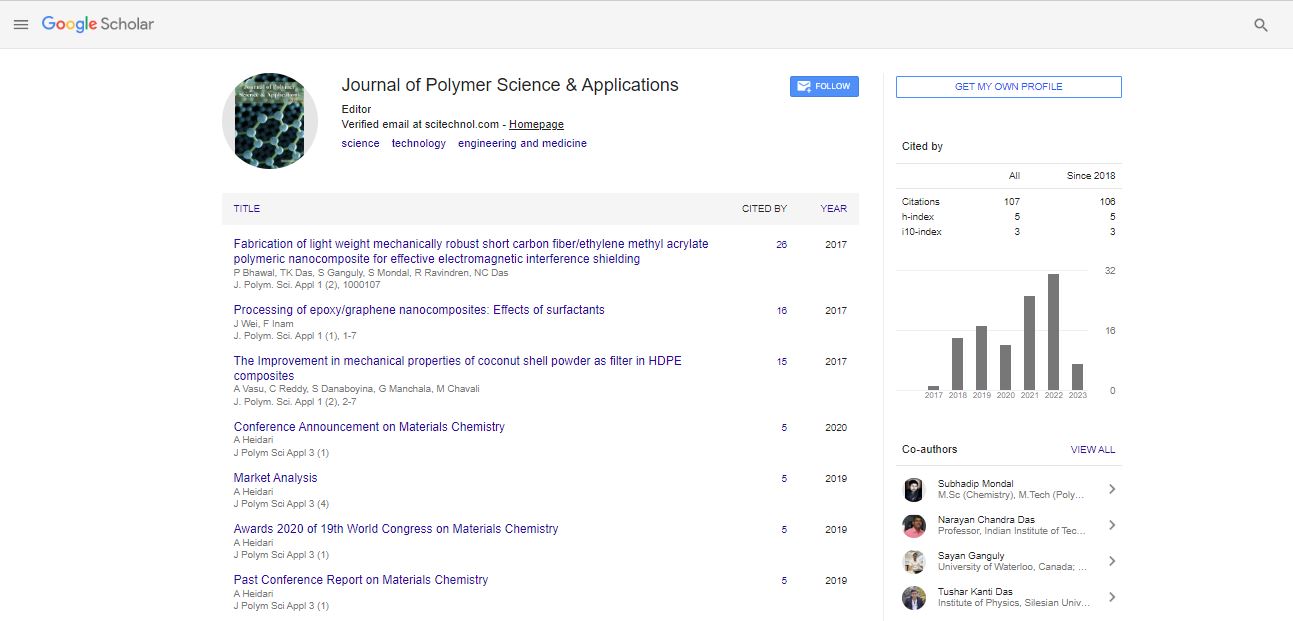Commentary, J Polym Sci Appl Vol: 7 Issue: 4
Enhancing Material Properties: A Comprehensive Guide to Polymer Surface Modification
Norharyati Guven*
1Department of Chemistry, Hacettepe University, BeytepeAnkara, Turkey
*Corresponding Author: Norharyati Guven,
Department of Chemistry, Hacettepe
University, BeytepeAnkara, Turkey
E-mail: guvennorharyati@gmail.com
Received date: 20 November, 2023 Manuscript No. JPSA-24-123400;
Editor assigned date: 22 November, 2023, PreQC No. JPSA-24-123400 (PQ);
Reviewed date: 06 December, 2023, QC No. JPSA-24-123400;
Revised date: 13 December, 2023, Manuscript No. JPSA-24-123400 (R);
Published date: 20 December, 2023, DOI: 10.4172/Jpsa.1000152
Citation: Guven N (2023) Enhancing Material Properties: A Comprehensive Guide to Polymer Surface Modification. J Polym Sci Appl 7:4.
Description
Polymers, a versatile class of materials, find applications in various industries due to their unique properties such as flexibility, low cost, and ease of processing. However, their inherent limitations, such as poor adhesion, hydrophobicity, and limited chemical reactivity, often pose challenges in specific applications. To overcome these limitations and unlock the full potential of polymers, researchers and engineers have turned to polymer surface modification techniques. These processes aim to alter the surface properties of polymers, enhancing characteristics like adhesion, wettability, and biocompatibility. In this article, we delve into the world of polymer surface modification, exploring different techniques, their applications, and the transformative impact they have on material performance.
Common techniques for polymer surface modification
One of the widely used techniques for polymer surface modification is plasma treatment. Plasma, a state of matter consisting of ionized gases, is employed to modify the surface chemistry of polymers. By exposing the polymer surface to a plasma environment, various chemical groups can be introduced, leading to improved adhesion properties. The reactive species generated during plasma treatment create active sites on the polymer surface, allowing for better bonding with adhesives or coatings.
Chemical grafting involves attaching functional groups to the polymer surface through covalent bonds. This method provides precise control over the modification process, allowing for tailored adjustments to the surface properties. Common grafting techniques include radiation-induced grafting and chemical reactions that introduce specific moieties onto the polymer chains. This approach is highly versatile, enabling the incorporation of desired functionalities without altering the bulk properties of the polymer.
Photografting is a surface modification technique that utilizes light to initiate chemical reactions on the polymer surface. Typically, a photosensitive initiator is applied to the polymer, and upon exposure to light, it triggers the grafting of functional groups. This method offers advantages such as spatial control and the ability to pattern specific regions of the polymer surface. Photografting is particularly useful in applications requiring selective modification, such as in microelectronics or biosensors.
Plasma polymerization involves the deposition of a thin film onto the polymer surface using plasma-generated monomers. The deposited film can impart new properties to the polymer, such as improved barrier properties, chemical resistance, or enhanced optical characteristics. Plasma polymerization is valuable for creating conformal coatings on complex-shaped polymer substrates, offering a uniform and controlled modification.
Applications of polymer surface modification
Polymer surface modification has revolutionized the field of biomedical devices. By enhancing the biocompatibility of polymers, they can be used in applications such as implants, drug delivery systems, and biosensors. Surface modifications, such as the introduction of bioactive molecules or anti-fouling coatings, ensure better integration with biological systems and reduce the risk of adverse reactions.
Adhesion is a critical factor in many industries, and polymer surface modification plays a key role in improving the bonding between polymers and other materials. Plasma treatment and chemical grafting, for instance, create a more receptive surface for adhesives, resulting in stronger and more durable bonds. This is particularly crucial in industries like automotive and aerospace, where adhesive technologies are widely employed.
In the realm of printed electronics, surface modification techniques enable the deposition of conductive inks on polymer substrates. Plasma treatment or chemical grafting can enhance the surface energy of the polymer, promoting better ink adhesion and conductivity. This has paved the way for flexible and lightweight electronic devices, including flexible displays and sensors.
The food and pharmaceutical industries benefit from polymer surface modification in the development of advanced packaging materials. Improved barrier properties achieved through techniques like plasma polymerization contribute to extended shelf life by preventing the permeation of gases and moisture. Additionally, modified surfaces can enhance the printability and appearance of packaging materials.
Polymer surface modification is a transformative field that opens up new possibilities for the use of polymers in diverse applications. Whether in biomedical devices, adhesive bonding, printed electronics, or packaging materials, the ability to tailor the surface properties of polymers allows for improved performance and expanded functionalities. As researchers continue to innovate in this field, we can anticipate even more breakthroughs that will shape the future of materials science and engineering.
 Spanish
Spanish  Chinese
Chinese  Russian
Russian  German
German  French
French  Japanese
Japanese  Portuguese
Portuguese  Hindi
Hindi 